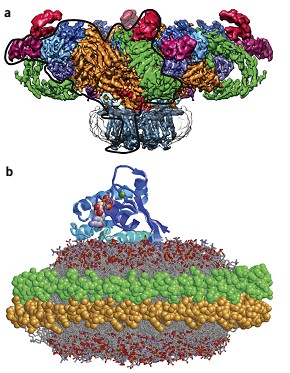Mempro™ Nanodisc for Structural Investigation of Membrane Proteins
During the past decades, Creative Biostructure has established an advanced and comprehensive nanodisc platform based on our Mempro™ Membrane Protein platform. Creative Biostructure can provide custom nanodisc as an example of discoidal nanoscale self-assembled lipid/protein particles. Our engineering Mempro™ Nanodisc technique has a lot of advantages over the traditional methods in membrane protein production and research, including the isolation, purification, structural resolution and functional characterization. Mempro™ Nanodisc Technology can be applied in a wide range of fields, especially in production of various functional membrane proteins in their native states allowing us to achieve better understanding of the structural details towards their interaction and signaling mechanisms.
 Figure 1. The structure of the ryanodine receptor in a nanodisc and the structure of KRas4b bound to the surface of a nanodisc. (Nature Structural & Molecular Biology, 2016)
Figure 1. The structure of the ryanodine receptor in a nanodisc and the structure of KRas4b bound to the surface of a nanodisc. (Nature Structural & Molecular Biology, 2016)
Mempro™ Nanodisc Technology has proven to be an invaluable tool to reveal the structure and function of isolated membrane proteins as well as their complexes with other ligands/receptors/lipids with a native membrane environment. Creative Biostructure has successfully incorporated various membrane proteins into customized nanodiscs to solve their crystallized structures.
Creative Biostructure has made a lot of efforts in the expanding use of nanodisc technology in structural biology in recent years, which made us the expert in membrane protein crystallization with our outstanding EM and X-ray techniques. Furthermore, Mempro™ Nanodisc platform is dedicated to offer an ideal water soluble lipid membrane system for structural studies of membrane proteins by using NMR. For example, CYP3A4 and Protective Antigen (PA) pore from Bacillus anthracis have recently been assembled into nanodisc formation in functionally native states to investigate their structure by both magic-angle spinning solid-state NMR and transmission electron tomography. Nanodisc incorporation is advantageous in comparison with liposome technology due to the simplification of the reconstruction analysis by the predominant 1:1 stochiometry.
Besides structural investigations, Mempro™ Nanodisc platform can be also applied on various studies of membrane proteins, such as protein-protein interaction, protein-lipids interaction, channels and transporters, ligand binding, antibody development, drug design, phage display, etc. Please feel free to contact us for a detailed quote, we assure you the best nanodisc products and the first-class services.
References:
G. Denisov, et al. (2016). Nanodiscs for structural and functional studies of membrane proteins. Nature Structural & Molecular Biology, 23: 481-486.
L. J. Catoire, et al. (2014). Micelles, bicelles, amphipols, nanodiscs, liposomes, or intact cells: the hitchhiker’s guide to the study of membrane proteins by NMR. Membrane Proteins Production for Structural Analysis, 315-345.
K. Malhotra, et al. (2014). Advances in the use of nanoscale bilayers to study membrane protein structure and function. Biotechnol. Genet. Eng. Rev. 30: 79-93.